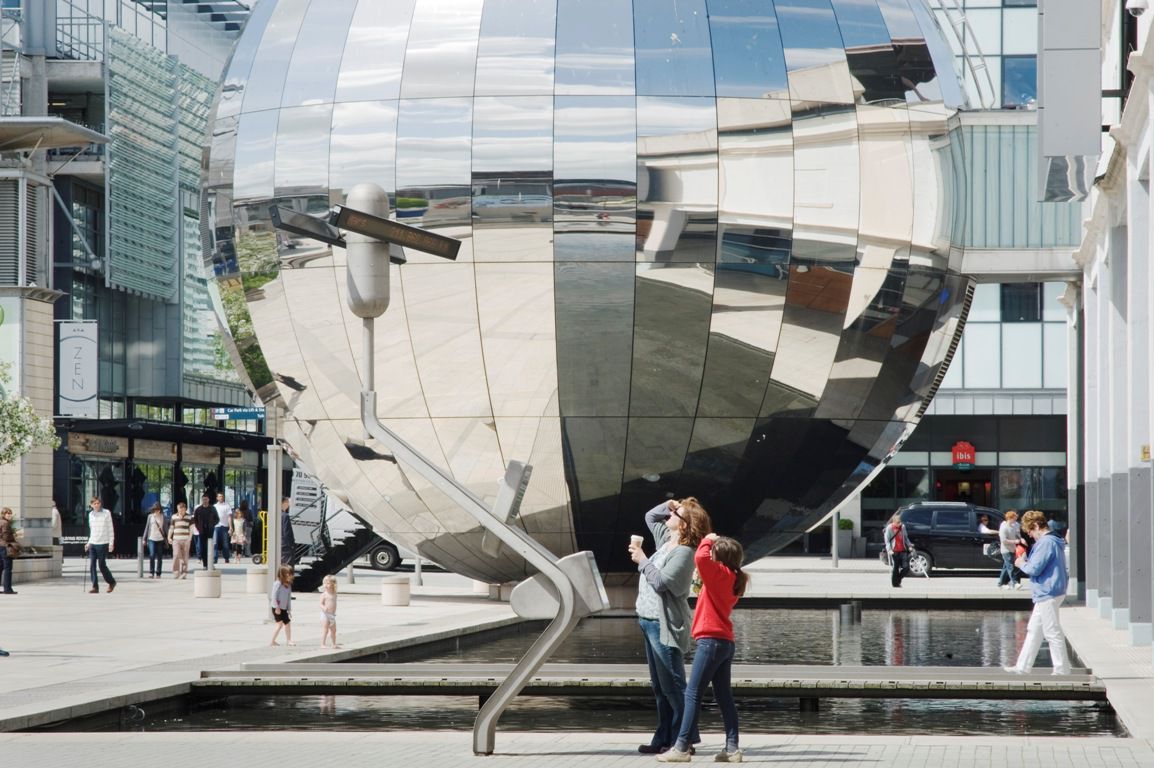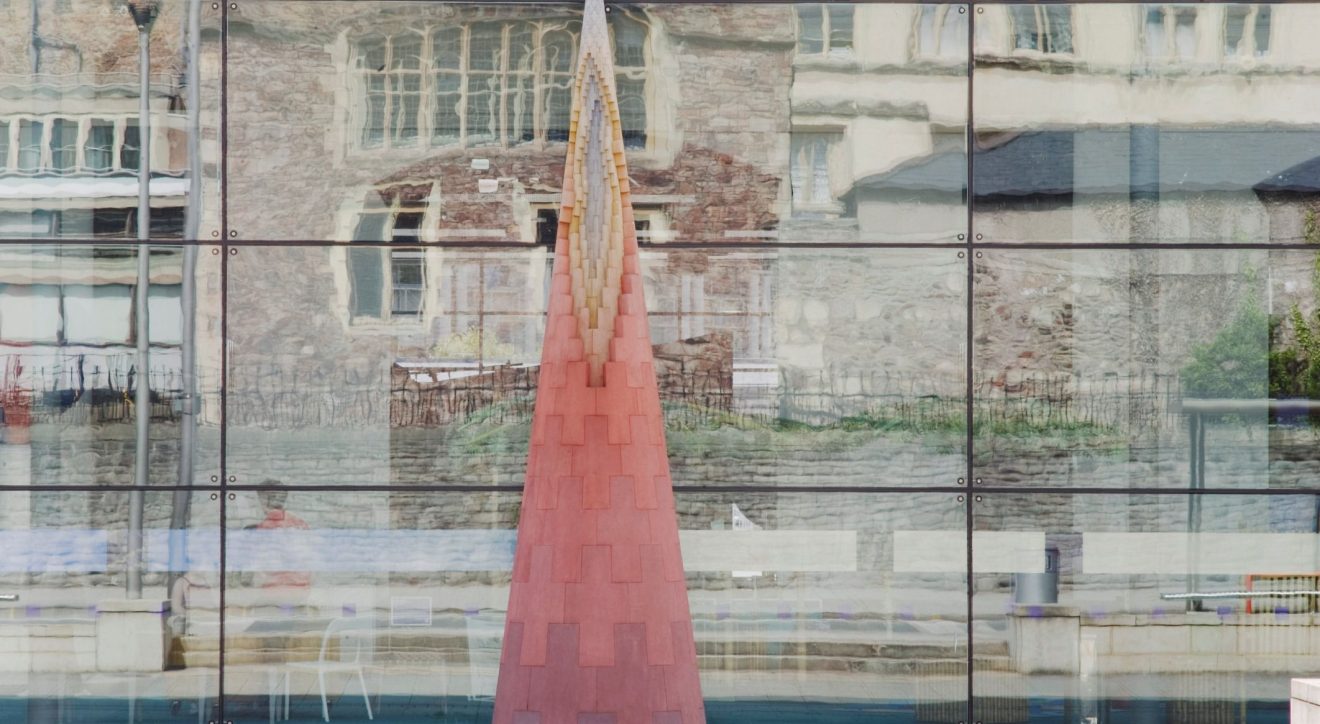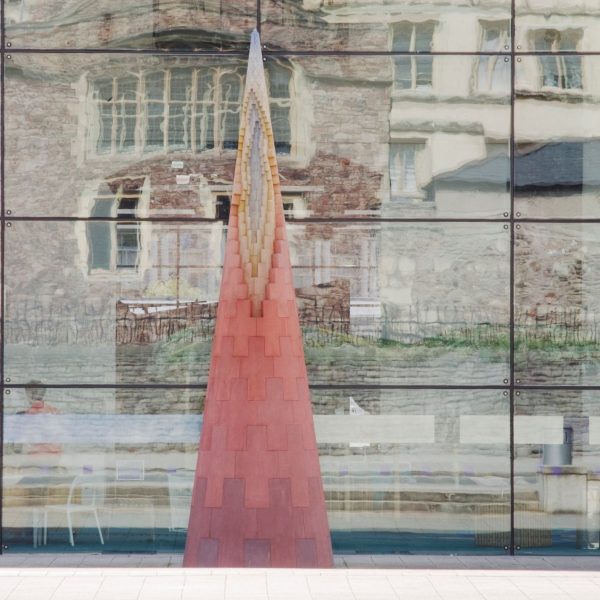
Synopsis
At-Bristol is an 11 acre educational visitor attraction which opened in July 2000 as part of a £450 million urban rejuvenation scheme. Located in Bristol’s Harbourside the regeneration project was made possible through substantial grant funding from the National Lottery via the Millennium Commission. It includes the one of the largest public art commissions programmes in the South West region with works by eight artists including Simon Thomas’ ‘Small Worlds’.
Description
Small Worlds is a dramatic cone formed sculpture which rises 18ft into the air. It is located in front of At-Bristol’s glazed façade that faces Anchor Road, and was made possible through sponsorship by the Institute of Physics. The work commemorates the work of Paul Dirac, the Nobel Prize winning scientist/mathematician who was born in Bristol. Paul Dirac is most famous for his contribution to the Quantum theory and his discovery of anti-matter.
Rather than trying to describe energy fields with static 3-D form, the artist has concentrated more on pointing towards the small worlds which Dirac studied – which gives the sculpture its name. Colour, heat and light are also vital elements in the artist’s approach as these natural phenomena are only described adequately by Quantum theory.
Simon Thomas’ dramatic interpretation of his subject presents the idea in a clustering of cones scaled by integrated proportional block-work. The colour of each block varies slightly from its neighbour, ranging from a cool dark magenta at the base area to a hotter and lighter sand colour at the top and centre, reminiscent of a flame.
Fabrication of the cone used innovative techniques – first a full-size polystyrene cone was covered in two layers of stainless steel mesh. This was supported by a purpose-built steel frame support while the entire cone was coated in two layers of ‘Fibrocem’ – a cement-rich render reinforced with alkali-resistant chopped strand glass fibre. Once the polystyrene was removed further coats of render where put on the inside. The outside was sandblasted to produce the required texture, and various pigments added to produce the essential colours.
Born in Portsmouth in 1960, Simon Thomas is known for his sculptures in both private and public collections.
The At Bristol Commissions Programme
The commissioning programme started in 1998/99, at the same time as the designs for the site were being developed. The commissions are all themed around the concepts of reflection and exploration. They include small-scale painted bronze sculptures Jasmine, and Bill and Bob by Cathie Pilkington, a large-scale bronze sculpture, Beetle by Nicola Hicks, and figurative bronzes of William Penn, William Tyndale and Thomas Chatterton by Lawrence Holofcener. Works using light include Zenith by David Ward which covers Millennium Square, and a text based work using neon light by Tim Noble and Sue Webster in the underground car park. William Pye’s large landscape piece using water, Aquarena, animates Millennium Square, while Simon Thomas’ sculpture Small Worlds, celebrating prize-winning physicist Paul Dirac, is in Anchor Place. An interactive digital work, Elematrix, by Tessa Eliot is inside the At-Bristol complex. With the exception of the two large works which are integral to Millennium Square, most of the works were made off-site and installed from 1999 and throughout 2000.
Three architects were involved in transforming the At-Bristol site with new buildings and landscaped open spaces which would complement the existing architectural heritage. Wildwalk and the Imax cinema were designed by Michael Hopkins and Partners, and Chris Wilkinson Architects (now Wilkinson Eyre) designed the building for Explore. The open spaces and squares were carefully planned by The Concept Planning Group (CPG) to accommodate the artists’ commissions and to provide areas suitable for live entertainment, such as street performers. CPG was also responsible for overseeing the installation of the commissioned artworks and the subsequent period of snagging and problem resolution.
The works have evoked a strong sense of ownership from local people and an emphatically positive reaction from visiting children and adults.
Individual Commissions
Millennium Square’s six unique, epic scale water sculptures which can also be drained to create a distinctive performance space.
Inspired by the Rhinoceros Beetle, an awesome presence: one of the world’s strongest creatures which can support up to 850 times its own weight on its back.
Bill and Bob by Cathie Pilkington
A life size tromp loil tableaux comprising of painted bronze jack russells, Bill and Bob, who swim in a puddle of rubber
A life-size bronze of Hollywood legend Cary Grant commemorates the achievements of the actor, who was born and bred in Bristol.
A dramatic 18ft cone expressing colour, light and heat. Commemorating Nobel Prize-winning scientist/mathematician, Paul Dirac.
William Penn, William Tyndale and Thomas Chatterton by Lawrence Holofcener
Spanning three centuries, Penn, Tyndale and Chatterton were all communicators who left a lasting legacy. Interact with them and temporarily distract them from their work.
A dramatic integrated light piece comprising 52 runway lights. Inspired by an analemma, the line traced by the sun recorded at noon over the course of a year, as used in the past by navigators, explorers and astronomers.
For further information on the At Bristol public art commissions see the At Bristol website or the related links on this page.


